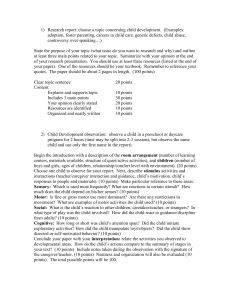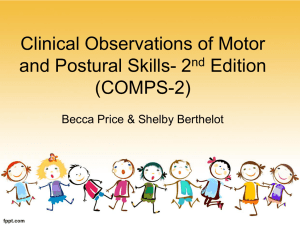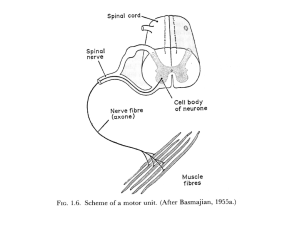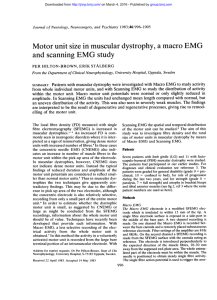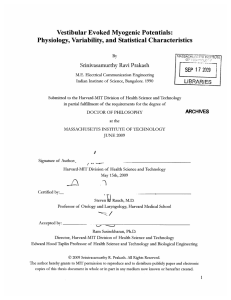Technology as a Scientific Tool for Studying Motor Behavior
advertisement
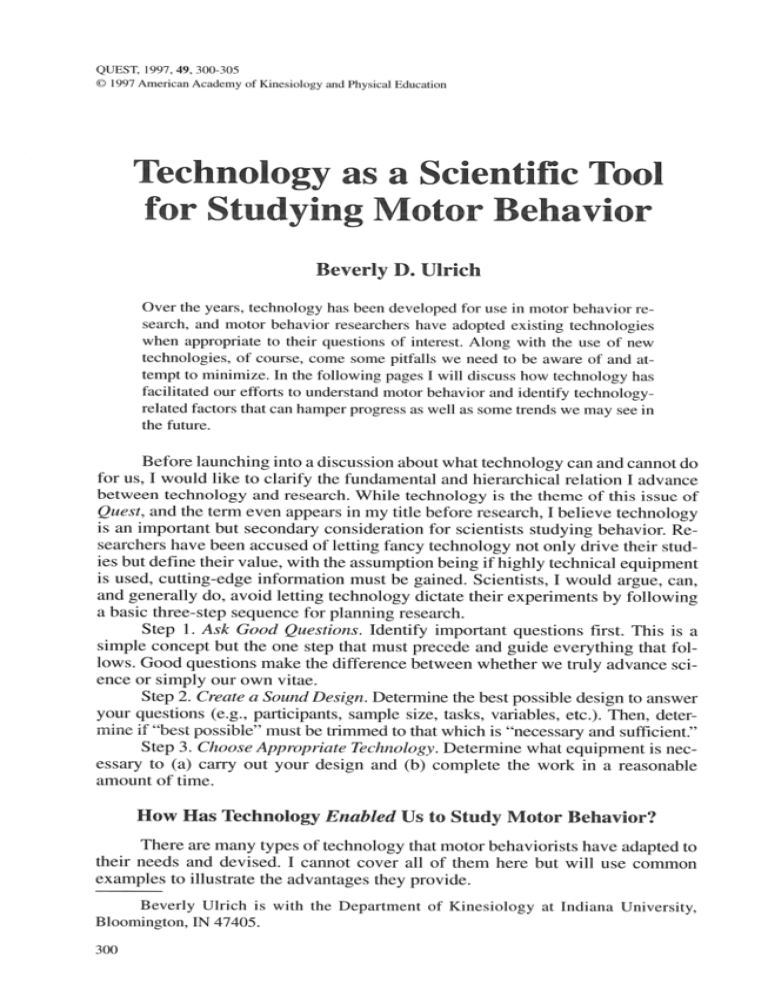
QUEST, 1997,49,300-305 O 1997 American Academy of Kinesiology and Physical Education Technology as a Scientific Tool for Studying Motor Behavior Beverly D. Ulrich Over the years, technology has been developed for use in motor behavior research, and motor behavior researchers have adopted existing technologies when appropriate to their questions of interest. Along with the use of new technologies, of course, come some pitfalls we need to be aware of and attempt to minimize. In the following pages I will discuss how technology has facilitated our efforts to understand motor behavior and identify technologyrelated factors that can hamper progress as well as some trends we may see in the future. Before launching into a discussion about what technology can and cannot do for us, I would like to clarify the fundamental and hierarchical relation I advance between technology and research. While technology is the theme of this issue of Quest, and the term even appears in my title before research, I believe technology is an important but secondary consideration for scientists studying behavior. Researchers have been accused of letting fancy technology not only drive their studies but define their value, with the assumption being if highly technical equipment is used, cutting-edge information must be gained. Scientists, I would argue, can, and generally do, avoid letting technology dictate their experiments by following a basic three-step sequence for planning research. Step 1. Ask Good Questions. Identify important questions first. This is a simple concept but the one step that must precede and guide everything that follows. Good questions make the difference between whether we truly advance science or simply our own vitae. Step 2. Create a Sound Design. Determine the best possible design to answer your questions (e.g., participants, sample size, tasks, variables, etc.). Then, determine if "best possible" must be trimmed to that which is "necessary and sufficient." Step 3. Choose Appropriate Technology. Determine what equipment is necessary to (a) cany out your design and (b) complete the work in a reasonable amount of time. How Has Technology Enabled Us to Study Motor Behavior? There are many types of technology that motor behaviorists have adapted to their needs and devised. I cannot cover all of them here but will use common examples to illustrate the advantages they provide. Beverly Ulrich is with the Department of Kinesiology at Indiana University, Bloomington, IN 47405. TECHNOLOGY AS A SCIENTIFIC TOOL 30 1 Computers At one level, movement scientists are merely among the masses of people whose work has improved because of the advent of computers. Specifically, computers enable us to be more efficient and to organize and process more data faster than ever before. Windows options allow for multitasking; with new graphics programs, we view data quicker and in more complex formats than ever. We save time and money by generatingpublication-qualitygraphs in our own laboratories. Computer-VCR interfaces enable us to view videotapes of behavior and record events of interest directly into a spreadsheet with just a keystroke (e.g., MacSHAPA, Sanderson, 1994). When we collect data on-line via computers, increases in buffer space and memory allow us to sample longer time periods and more channels of input simultaneously than ever before. Longer time samples mean we can analyze movement embedded in its natural context rather than only cued behaviors. For example, infants seldom act on cue. To capture important events, we must begin collecting before we think they will begin to reach or walk and continue until they complete the task. More channels of input means we can simultaneouslycollect information about multiple factors that underlie or describe movement. This could be several channels of electromyographic (EMG) activity and infrared light-emitting diodes (LEDs), for example. This results in richer descriptions of the variability inherent in individual actions. The portability of computers makes field work easier and more efficient. Laptops can be used to enter demographic and anthropometric data, thus eliminating errors that can occur when data are transferred from hard copy to spreadsheet and saving time as well. We also can interface laptops with EMG or other movement data collection systems, thus enabling us to work with populations unable to come into the laboratory for testing. One of the most exciting ways in which computer technology has been tapped to further theory-building in motor behavior has been to develop techniques that enable researchers to study relations between perception and action. For example, in 1973 Johansson developed point-light displays, which are films of people moving, that showed only bright dots corresponding to body joints moving on a dark background. Viewers easily recognized categories of human movement based on the unique temporal relations among the dots. Today, movement scientists use computer programs to synthesize point-light displays and study how recognition of biological movement emerges and how such seemingly simple bits of information can invoke complex perceptions (Bertenthal & Kramer, 1984; Bertenthal & Pinto, 2993; Todd, 1983). Other researchers have designed computer algorithms and displays to study how people search the perceptual-motor work space for solutions to novel tasks (Fowler & Turvey, 1978; Krinskii & Shik, 1964; McDonald, van Ernrnerik, Kugler, & Newell, 1990). Computer simulations allow scientists to control explicitly the structure of the work space and the available solutions. Then performers' strategies, used to locate solutions and their responses to the dynamic flow of information involved in the organism-environment interaction, can be analyzed. Methodologies such as these allow us to explore how our own motion affects our perception of the world and, concurrently, how our perceptions affect our actions. Movement Data Collection Systems Next to the computer, systems that collect information which specify the location of body segments or joints in space may be the most prevalent technology used by motor behavior researchers. What we accomplish today with systems of reflective markers and LEDs, researchers began many years ago when they behavior-coded and digitized film records. We continue to use these systems to describe, but also to attempt to explain, how people move. Newer technologies increase the speed and ease with which such data can be captured and processed. With LED systems (e.g., Optotrak, MacReflex), we can look at data within seconds of collection and test participants in complete darkness if, for example, we want to study the effects of vision loss on movement trajectories. Video-based systems allow data to be collected without the need for computer-driven programs and with minimal hardware (e.g., Peak Performance Technologies, Ariel Dynamics). Multiple users can collect data simultaneously in different locations and process the videotapes later via a shared computer-VCR system. Electromyography (EMG) Like movement data collection systems, techniques to monitor the electrical activity of muscles have been available for years. Technical advances have made these systems more accessible, more portable, and easier to maintain. Driving data collection via a computer, with its inherent storage capacity, enables us to collect and convert analog data to digital virtually on-line, as well as to synchronize EMG data with other information about the mover's physiological or kinematic activity. Portable computers, compact EMG processing systems, and telemetry systems make collecting data outside of the laboratory, in real movement contexts, feasible. Surface electrodes, with amplifiers attached in close proximity, have reduced the noise inherent in these data and make the movements of unskilled performers--ones whose muscle activation patterns have yet to stabilize--easier to interpret. Force Plates A mainstay in many motor behavior laboratories has been the force plate. With this technology we can address issues concerning how well one can avoid moving (static postural control) or control the distribution of forces when moving (dynamic postural control). The data collected reflect the location of the center of mass relative to one's base of support at sequential points in time and the direction and magnitude of forces produced. Postural control continues to be an area of great interest in motor behavior and about which there is much theoretical debate. Force plates and EMG technology have been instrumental in enabling us to move beyond simple quantitative performance scores to measure postural control or balance. With traditional tasks, such as beam walking and attempting to keep a stabilometer platform horizontal, we usually simply assessed outcomes-performance on tasks designed to measure the dichotomous dynamic and static postural control. Such measurements offered little help in explaining the process of how we control our bodies as we move through space. TECHNOLOGYAS A SCIENTIFIC TOOL How Has Technology Constrained Our Efforts to Study Motor Behavior? Clearly, technology can't really do anything by itself. But to use technology wisely, we need to be aware of ways research equipment can be as much a burden as a boon. Price Tags Most research technology is expensive. Beyond the initial purchase price, the cost of technical support often must be factored in, paid to the vendor or to university support staff. Upgrades are another ongoing cost. As newer versions of the software driving our systems come on the market, we usually want to acquire the new features. Eventually, vendors discontinue support for old versions, sometimes making upgrades necessary. The burden of funding major equipment purchases often falls on the researcher, via grant writing. It is quite common for a significant portion of the direct costs of any research grant to be allocated to technology. Grants are, of course, time-consuming to write and there are no guarantees of success. But if our research equipment costs are high, common practice is for universities to expect that we seek external funds to support our work just as is expected of faculty in other departments, like physics, biology, and psychology. "Tail Wags the Dog" Syndrome This syndrome occurs when the technology available in the lab determines the questions that are asked. The existence of this syndrome is suspect when the same protocol is used again and again with simple variations in (a) the participants (e.g., older, younger, male, female, disabled) or (b) the task (e.g., eyes open, eyes closed). The concern is that the studies exist because the technique is readily available, not because this new population or task variation will answer the next "burning" question. This is an easy pitfall to make. Often we invest many hours writing or customizing programs, building or wiring pieces of equipment for a specific protocol, and teaching students and research assistants how to use the available laboratory equipment. But, we can minimize the tendency to get stuck in a technology or paradigm that has outlived its usefulness if we remind ourselves to ask good, theorydriven questions (see p. 300). Reductionism Sophisticatedtechnology enables us to focus on one subsystem (e.g., neural, muscular, visual) in fine detail. If we pursue the subsystem, without embedding our work in the system's functional behaviors, we become reductionistic. That is, we may simply be able to describe how an isolated mechanism works. That is not necessarily bad, unless our goal is to understand behavior. In that case, we need to build into our research programs the goal of using what we've learned about isolated subsystems by studying their role in the richer context of functional movement. High Technology Is Expected Grant and journal article reviewers (among others) tend to perceive work that involves lots of complex equipment to be advanced theoretically as well as technically. Of course, sophisticated tools and even precise, large data sets do not guarantee information that will move us forward, toward a better theoretical or empirical explanation of behavior. Being a good technician doesn't equate with being a good scientist.Nevertheless,many questions necessitate sophisticatedequipment. As scientists, we must weigh the pros and cons of technology relevant to our research questions and decide for ourselves what is necessary. The burden is ultimately ours to convince readers of the importance of our questions/results and the appropriateness of whatever techniques we used via the force and clarity of our writing. Conclusions and Future Directions What kinds of technology will we be using in motor behavior research in the future? That's difficult to predict. Two possibilities derive from advances in medical technology. The first includes systems that allow us to monitor brain activity in multiple sites simultaneously, including multichannel EEG, functional MRI, SQUID arrays, etc. With these techniques, researchers are beginning to examine the dynamic nature of neural activity in perceptual categorization and learning (e.g., Etnier, Whitwer, Landers, Petruzzello, & Salazar, 1996; Kelso, 1995). The second includes systems that provide greater resolution and larger field of view in the imaging of fetal behavior, that is, more sophisticated ultrasound equipment and Doppler techniques. These techniques allow us to study in more detail the emergence of motor behaviors, prebirth (e.g., DiPietro, Hodgson, Costigan, Hilton, &Johnson, 1996; Riegger-Krugh, Blair, & Sparling, 1996). Beyond new technology, I expect we will see a trend toward using what we have more efficiently. Sharing technology is economical; one department or school can purchase more equipment if each EMG system, force plate, set of computer programs, and so forth is used distributively. Sharing technology, and even research space, is not only economical, but it can also lead to more integrated and collaborative activity among researchers. Increasing emphasis in the scientific community on collaborative work is evidenced by the fact that federal funding agencies have expanded their efforts to fund multidisciplinary research and training programs. Most existing departmental research facilities have physically separated laboratory spaces for faculty in each subdiscipline. Moving equipment or subjects between laboratories is not easy but sometimes necessary. In the future, shared space, in the form of research centers with central testing areas surrounded by data reduction stations and office space, will likely become more common. References Bertenthal, B.I., & Kramer, S.J. (1984). The TMS 9918 VDP: A new device for generating moving displays on a microcomputer.Behavior Research Methods, Instruments, and Computers, 16,388-394. Bertentbd, B.I., & Pinto, J. (1993). CompIementary processes in the perception and production of human movements. In L.B. Smith & E. TheIen (Eds.), A & m i c systems appraach to development:Applicatiolrs (pp. 209-239). Cambridge, MA: MIT Press. 'ZP-1s '(7)6 'a3uvuuo~adpun uoy -da3rad UWHH :k8010ZpXSd lv~uaur?radxgJo ~Vurnof.)!?28 $0 uopda3lad '(£861) 'xf'PPOJ, xalua3 s!sdlewj u o g e u u o ~ us3~ouo8.13 ~ uralsds Ma13 :HO 'muosla~lL?d-ly8p~ .u.UOJO~~?A pun 3?uon3alaU? p2332ll03 VlVp1vuo~lvMasqo 8u? -2iC/VUvpUV ' ~ u ? M '~~U?JV ? A .L ~WI?d0Jl00l ~ ~ V @ O SV :VdVHS3Vm '(~661)'ma '~OSlapUes '981-ELI '(z)91 'S3?13~?pad U? Xdvraztl, lvuo~~vdn330 pun /v3?sXqd .auyao3 01a~nsodxap l e u a ~ d j ova#a aql aiqmalap 01poqlam a ~ q ~ s s eo dse h p o ~ a ~ nqn8w a a q p j a j JO luaurssassv .(9661) 'XI 'Ku!pds 'B "v ' 1 ~ 1 8"3 'y8q-.1aK8a% ' 168 '9T 'Sl3vJJf -qv a3ua?rnorna~ roJiQa?3oS'luauranour paleu!p.~ooz~jo uo!~!s!nb3e ayL :suo!lnIos d '.tr.a.a 'qtaunua r n 'i\.d ~ 'pIeuoa3N 103 Bu!y3nas '(0661) 'N)I'IIaMaN 78 ' ' ~ 'la18n)I '999-799 '6 's3?sXqdo?g'ysel lolour a~dur!s v .(p961) ' 7 ' 'WS ~ 'B "IA '!qsu!w ~ 'a8ppq 'ssald J I :VN -me3 .ro?nvzjaqpuv u?vnqJoU O ? I V ~ ? U V ~ . ~ Oa- ~u~ S:sura~vd3?urvuXa'(5661) ' S ~ ' OI S I ~ ~ '1 IZ-IOZ 'PK ' s ~ ? s Q ~ oPUV ~ ~uoqda3rad ~CS~ .s!sdpue sly l o j lapour e p w uo!lour p3!%01o!q jo uo!lda3lad lens!A ' ( ~ ~ 6 '9 1 )'uosswyo~ 'SSaQ 3 F a P 3 v :pOA MaN '(0~-1.dd) Zu?utval puv loau03 dolour u? 8u?ssa3ond uo~~vuuoJuz '(.pa) y ~ e u r ~ a ~ s '3.9 UI .salqeya IelaAas jo uog3unj e jo urntugdo aql 103 8uyy3reas 01 amaIaja1 '3 @pads q l ! ~q3eordde JuaAa u v :uogls!nb3e 11qs '(8~61)-xm ' d a m 1 'B ' " ~'1aIMod '6LZ-ZLZ ' ~ 'pods 9 puv as?3.~axg nojX1ra~rvnaqavas -a8 'YSQ lolorn p ~ o eu 8umleaI q l ! ~pal~y3ossed p ~ p 3 3!qde1%o~qda3uao43ap e u! sa8wq3 '(9661) i~ ' ~ m p 1s8 "rs 'o1pzmnad '.Na 'slapw? "S'S 'lawFqM "TI ' l a w 3 'L~SZ-ESSZ ' ~ '~uamdolanaa 9 p l ? .maurdolanap ~ Ieloraeyaqoxnau @lad '(9661) 'SxJ,'UOSUqOf 'B ''2s 'UOjI!H "v)I' U E ~ ~ S"O ~~ 'UOS~POH a '-v'I'o.I$a!d!a SO£ TOOL 3 H L N X I 3 S V SV hE)O?ONH3EIL






